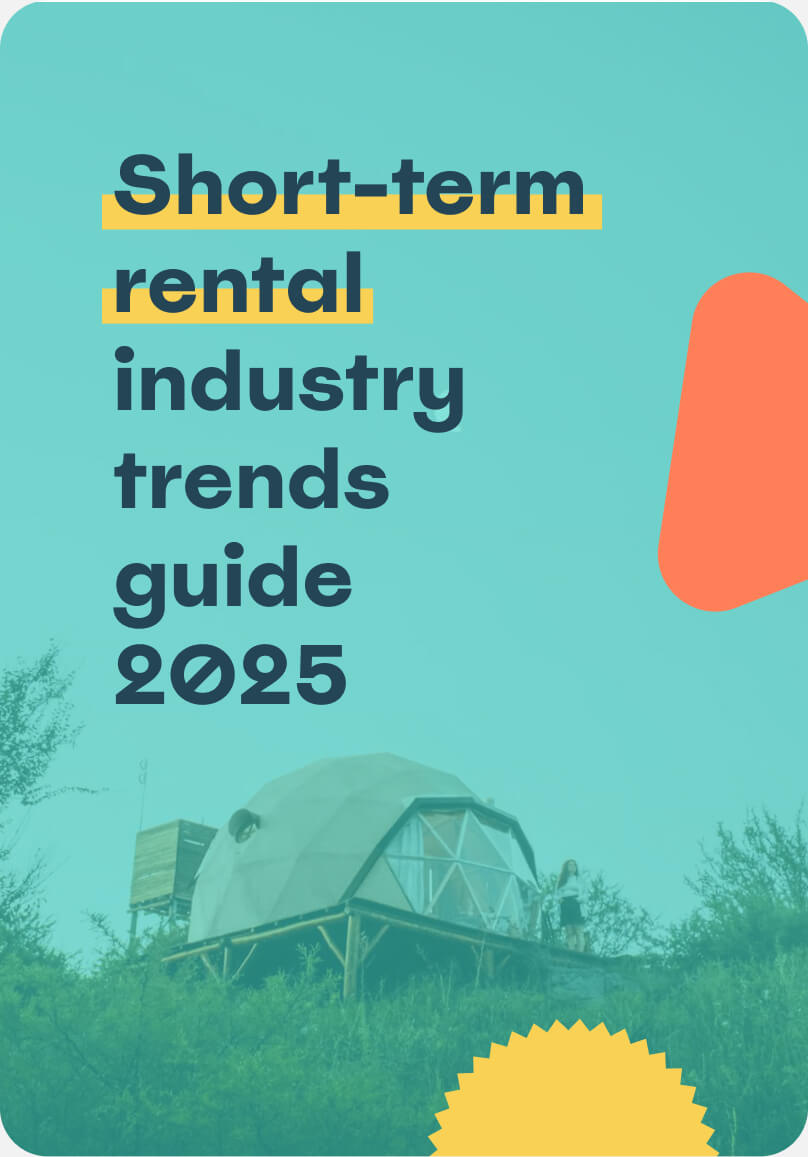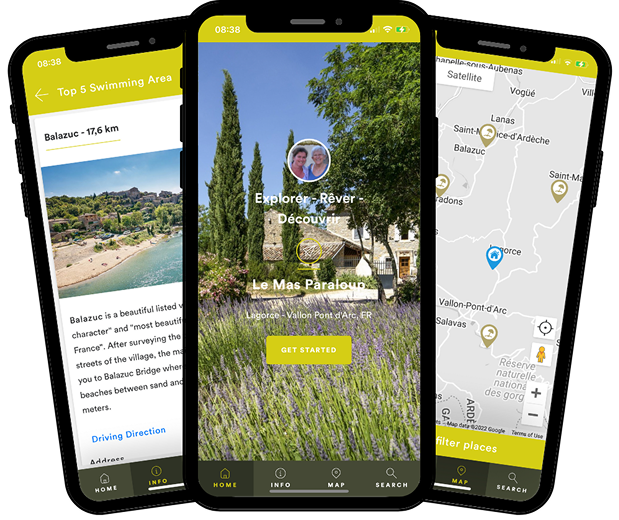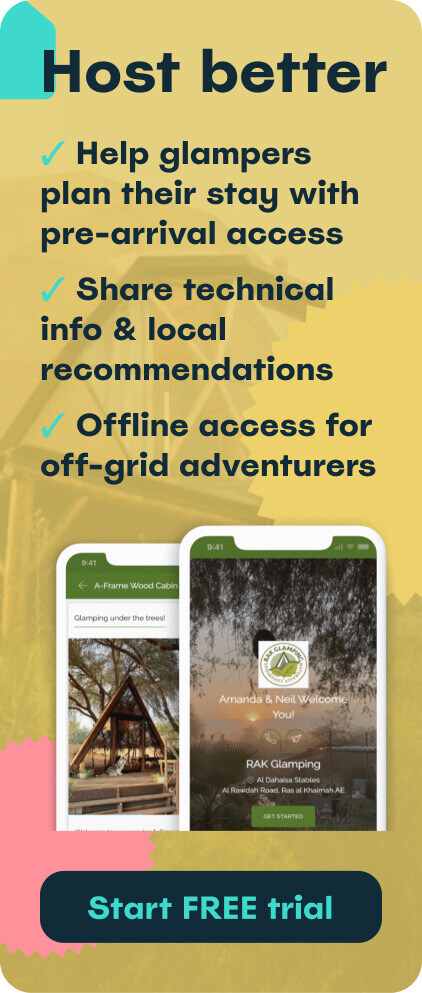In recent years, the travel industry has witnessed a remarkable surge in the popularity of glamping, a portmanteau of ‘glamorous’ and ‘camping.’ This innovative concept has captured the hearts of nature enthusiasts and luxury seekers alike, offering a unique blend of outdoor adventure and upscale comfort. For entrepreneurs looking to tap into this growing market, starting a glamping business presents an exciting opportunity to combine hospitality with nature-based experiences.
Take the easy route to a successful glamping business with a Touch Stay digital guidebook. Designed especially for glampsite owners, a digital guidebook lets you help glampers plan their best stay by sharing essential info and local recommendations. Plus, they work offline - ideal for off-grid adventures!
Start your 14-day free trial today and join the 86% of users who have already halved the time spent answering guest questions!
This comprehensive guide will walk you through the essential steps of launching and running a successful glamping business. Whether you're a seasoned hospitality professional or a nature lover with an entrepreneurial spirit, this article will provide you with the knowledge and insights needed to turn your glamping dreams into reality.
In this in-depth exploration of the glamping business, we'll cover:
- The fundamentals of glamping and its market potential
- Research and planning strategies
- Securing the perfect location
- Legal and regulatory requirements
- Types of glamping accomodations
- Creating a solid business plan
- Marketing your glamping business
- Financial management and pricing strategies
Introduction to glamping business
Glamping, at its core, is a fusion of traditional camping with the luxuries and amenities typically found in high-end hotels. This innovative concept has redefined outdoor accommodation, offering travellers a way to immerse themselves in nature without sacrificing comfort or style.
Glamping accommodations come in various forms, including:
- Luxury safari tents with plush bedding and private bathrooms
- Treehouses equipped with modern amenities and stunning views
- Yurts featuring spacious interiors and cosy furnishings
- Eco-pods designed for sustainability and comfort
- Converted Airstream trailers with retro charm and modern conveniences
- Geodesic domes offering unique architectural experiences in nature
The appeal of glamping lies in its ability to attract a diverse range of travellers, from outdoor enthusiasts seeking a more comfortable camping experience to luxury travellers looking for unique, Instagram-worthy stays. This broad appeal has contributed to the rapid growth of the glamping industry worldwide.
- The global glamping market is experiencing significant expansion, with projected CAGR of 10.9% from 2023 to 2030.
- Increasing interest in sustainable and eco-friendly travel options is driving demand for glamping experiences, as many sites focus on minimal environmental impact and nature conservation.
- The COVID-19 pandemic has accelerated the trend towards outdoor and socially distanced vacations, further boosting the glamping sector.
Source: Grand View research
As the tourism industry continues to evolve, glamping stands out as a sector with immense potential for growth and innovation. Entrepreneurs entering this market have the opportunity to create unique, memorable experiences that cater to the changing preferences of modern travellers.
Research and planning
Before diving headfirst into the glamping business, it's crucial to conduct thorough market research and develop a comprehensive plan. This foundational work will inform your business decisions and help you create a glamping experience that stands out in an increasingly competitive market.
Identifying target audience
Understanding your potential customers is key to tailoring your glamping offerings and marketing strategies effectively. The glamping market attracts a diverse range of travellers, but certain demographics tend to be particularly drawn to this type of experience.
Typical glamping enthusiasts include:
- Millennials and Gen X (ages 25-54): often seeking unique, shareable experiences
- Middle to high-income earners: willing to pay a premium for comfort in nature
- Nature lovers who appreciate comfort: Looking for outdoor experiences without roughing it
- Adventure seekers and experiential travellers: interested in novel accommodation types
- Eco-conscious individuals: attracted to sustainable and low-impact travel options
- Couples seeking romantic getaways: drawn to the privacy and uniqueness of glamping
- Families looking for child-friendly outdoor experiences: appreciate the safety and amenities of glamping sites
Understanding these demographics will help you tailor your offerings, from the types of accommodations you provide to the activities and amenities you offer on-site.
By creating detailed customer personas, you can better understand the needs, preferences, and pain points of your target audience. This information will guide your decisions on everything from site location and accommodation types to marketing messages and pricing strategies.
Competitor analysis
A thorough competitor analysis is crucial for identifying market gaps and opportunities for differentiation. This process involves researching existing glamping sites in your target area and evaluating their offerings, pricing, and unique selling points.
Steps for effective competitor analysis:
1. Identify direct and indirect competitors:
-
- Direct competitors: other glamping sites in your region
- Indirect competitors: traditional campgrounds, boutique hotels, and vacation rentals
2. Analyse their offerings:
-
- Types of accommodations provided
- Amenities and services offered
- Unique experiences or activities
- Pricing structure and packages
3. Evaluate their online presence:
-
- Website design and functionality
- Social media activity and engagement
- Online booking capabilities
- Customer reviews and ratings
4. Assess their strengths and weaknesses:
-
- What do they do well?
- Where are there gaps in their offerings?
- How can you differentiate your glamping site?
5. Identify market gaps:
-
- Are there underserved customer segments?
- Are there unique locations or experiences not being offered?
- Is there a need for specific types of accommodations or amenities?
6. Learn from customer feedback:
-
- Read reviews to understand what guests love and what they find lacking
- Look for recurring complaints or suggestions for improvement
By conducting a thorough competitor analysis, you can position your glamping business to fill gaps in the market and offer unique value to potential guests. This information will be invaluable as you move forward with your business planning and site development.
Securing a location
The success of your glamping business heavily depends on choosing the right location. A perfect site can elevate the guest experience and set your business apart from competitors. When evaluating potential locations, consider the following factors:
1. Scenic beauty and natural attractions:
-
- Look for sites with stunning views, diverse landscapes, or unique natural features
- Proximity to lakes, rivers, mountains, or forests can enhance the glamping experience
- Consider the potential for stargazing, wildlife viewing, or other nature-based activities
2. Accessibility:
-
- Balance the desire for seclusion with the need for reasonable access
- Ensure roads are suitable for guest vehicles and supply deliveries
- Consider proximity to airports or major highways for out-of-town visitors
3. Proximity to popular tourist destinations:
-
- Being near national parks, historic sites, or popular attractions can increase appeal
- Consider the potential for partnerships with local tour operators or activity providers
4. Local climate and seasonal considerations:
-
- Evaluate the climate and weather patterns throughout the year
- Consider how seasonal changes might affect your business operations
- Plan for potential natural hazards (e.g., floods, wildfires) and have mitigation strategies
5. Availability of utilities and infrastructure:
-
- Access to water, electricity, and sewage systems (or alternatives like septic tanks)
- Possibility of installing eco-friendly systems (solar power, rainwater collection)
- Cell phone coverage and internet connectivity options
6. Zoning and land use regulations:
-
- Ensure the land is zoned for commercial hospitality use
- Check for any restrictions on development or business activities
7. Size and topography:
-
- Adequate space for planned accommodations, amenities, and future expansion
- Suitable terrain for building and creating access paths
8. Local community and culture:
-
- Consider the relationship with nearby communities
- Potential for showcasing local culture, art, or cuisine as part of the glamping experience
9. Environmental impact:
-
- Assess the potential impact of your glamping site on the local ecosystem
- Plan for sustainable practices to minimise environmental disturbance
10. Purchase vs. lease options:
-
- Evaluate the pros and cons of buying land versus leasing
- Consider long-term plans and potential for property value appreciation
Download our FREE checklist to make sure sure you don’t miss anything when looking for a glamping site:
Discover what to look for in a glampsite...
Things to consider when evaluating potential glamping locations:
- Visit sites in person at different times of day and seasons
- Balance natural beauty with practical considerations
- Assess accessibility and infrastructure development challenges
- Evaluate the location's potential to provide a sense of escape
- Consider how the location could contribute to your brand and appeal
- Take your time with the decision
- Consider working with a specialist estate agent for rural or recreational properties
Legal and regulatory requirements
Navigating the legal landscape is crucial for a smooth start to your glamping business. Requirements can vary significantly depending on your location, so it's essential to research and comply with all relevant regulations. Here's an overview of key legal considerations, split into sections for North America and Europe:
Europe
1. Planning permission:
-
- Obtain approval from local planning authorities for change of land use
- May require detailed site plans and environmental impact assessments
- Planning Portal provides guidance on planning permission, including requirements for change of use to glamping
2. Tourism licences:
-
- Register with the local tourist board
- Obtain necessary licences for operating a hospitality business
- VisitBritain offers resources and advice for tourism businesses, including licensing and regulations
3. EU regulations:
-
- Comply with EU-wide standards for accommodation providers
- Adhere to General Data Protection Regulation (GDPR) for handling guest data
4. Health and safety:
-
- Comply with EU and local health and safety regulations
- Regular inspections may be required
- Health and Safety Executive (HSE) provides guidance on health and safety regulations for businesses, including accommodation providers
5. Environmental regulations:
-
- Adhere to local and EU environmental protection laws
- Consider sustainability certifications relevant to your region
- The Environment Agency provides information on environmental regulations and permits for businesses
6. Insurance:
-
- Public liability insurance
- Buildings and contents insurance
- Consider specialised glamping insurance policies
7. Tax considerations:
-
- Register for VAT if your turnover exceeds the threshold
- Understand local tourism taxes and how they apply to your business
- HMRC provides guidance on tax obligations for businesses, including VAT and corporation tax
8. Employment laws:
-
- Comply with EU and local employment regulations if hiring staff
- Consider seasonal worker regulations if applicable
North America
1. Business licences and permits:
-
- General business licence from your local municipality
- Special use permits for operating on certain types of land
- Lodging licence or permit specific to short-term rentals
- Small Business Administration (SBA) offers resources and advice for starting a business, including legal and regulatory information
2. Zoning laws:
-
- Ensure your property is zoned for commercial hospitality use
- You may need to apply for a zoning variance or special use permit
3. Health and safety regulations:
-
- Food safety permits if providing meals or snacks
- Fire safety compliance, including proper placement of fire extinguishers and smoke detectors
- Regular health and safety inspections may be required
- Occupational Safety and Health Administration (OSHA) provides guidance on health and safety regulations for businesses, including accommodation providers
4. Building codes and permits:
-
- Building permits for constructing or modifying structures
- Compliance with accessibility requirements (ADA in the US)
5. Environmental regulations:
-
- Environmental impact assessments may be required
- Permits for water usage, waste management, and land development
- Compliance with protected species regulations if applicable
- The Environmental Protection Agency (EPA) provides information on environmental regulations for businesses, including permitting and compliance
6. Insurance:
-
- General liability insurance
- Property insurance
- Workers' compensation insurance if you have employees
7. Tax considerations:
-
- Register for federal and state tax ID numbers
- Understand and comply with sales tax requirements
- Property tax implications of commercial use
- The Internal Revenue Service (IRS) provides information on tax obligations for businesses, including federal income tax and payroll taxes
Given the complexity of legal and regulatory requirements, it's advisable to consult with local legal and business advisors who specialise in hospitality or tourism. They can provide tailored advice based on your specific location and business model.
Remember that compliance is an ongoing process. Stay informed about changes in regulations and be prepared to adapt your business practices as needed. Joining local tourism associations or glamping networks can be a valuable way to stay updated on industry-specific regulations and best practices.Setting up the glamping site
Creating a memorable glamping experience starts with thoughtful site design and high-quality accommodations. This section will guide you through the key considerations for setting up your glamping site.
Types of glamping accommodations
The type of accommodations you choose will largely define your glamping site's character and appeal. Consider offering a mix of options to cater to different preferences and group sizes. Popular glamping accommodation types include:
- Yurts: circular structures inspired by traditional Mongolian dwellings
- Safari tents: large, sturdy tents with proper flooring and furnishings
- Treehouses: elevated structures that offer a unique perspective and childhood nostalgia
- Eco-pods: compact, often futuristic-looking units with a focus on sustainability
- Luxury cabins: more traditional structures with high-end finishes and amenities
- Airstream trailers: vintage or modern trailers that offer a classic Americana feel
- Geodesic domes: spherical structures that provide a unique architectural experience
- Tiny houses: small, often mobile homes that maximise space efficiency
- Bell tents: simple yet elegant canvas tents, easy to set up and move
- Converted structures: repurposed items like shipping containers or train cars
When selecting accommodation types, consider:
- Your target audience preferences
- The local climate and weather conditions
- The natural surroundings and how each structure might complement the landscape
- Initial investment costs and ongoing maintenance requirements
- Potential for uniqueness or Instagram-worthy appeal
Site layout and design
Thoughtful site layout is crucial for creating a cohesive and enjoyable glamping experience. Consider the following when planning your site:
- Privacy between units: ensure sufficient space and natural screening between accommodations
- Views: maximise scenic views from each unit where possible
- Accessibility: create clear, well-lit paths to all accommodations and common areas
- Communal areas: design inviting spaces for guest interaction, such as fire pits or outdoor lounges
- Natural integration: blend structures and pathways with the natural landscape
- Utilities placement: plan efficient routing for water, electricity, and waste management
- Parking: provide convenient parking without detracting from the natural setting
- Future expansion: allow space for potential addition of units or amenities
Infrastructure and amenities
The right balance of amenities can elevate the glamping experience while maintaining a connection to nature. Consider including:
When planning your amenities, consider:
- The balance between luxury and maintaining a connection with nature
- Sustainability features like solar power or rainwater collection systems
- Unique amenities that can set your site apart (e.g., stargazing equipment, outdoor cinema)
- Accessibility features to accommodate guests with different needs
Cost considerations
Initial setup costs can vary widely depending on the scale and luxury level of your glamping site. Here's a rough breakdown of potential costs:
Land acquisition: £75,000 - £400,000+
- Costs vary significantly based on location and property size
- May be lower if leasing land instead of purchasing
Site development: £30,000 - £150,000
- Clearing and levelling land
- Creating access roads
- Landscaping and outdoor areas
Accommodations (10 units): £75,000 - £400,000
- Varies based on type and quality of structures (e.g., yurts, treehouses, luxury tents)
- Includes foundations and basic interior finishes
Utilities and infrastructure: £35,000 - £150,000
- Water supply and treatment systems
- Electrical systems, possibly including solar installations
- Septic systems or eco-friendly alternatives
- Wi-Fi and communication infrastructure
Furnishings and amenities: £35,000 - £150,000
- High-quality beds and linens
- Indoor and outdoor furniture
- Kitchen equipment and appliances
- Bathroom fixtures and accessories
Landscaping and outdoor areas: £15,000 - £75,000
- Pathways and lighting
- Communal areas (e.g., fire pits, BBQ areas)
- Gardens and natural landscaping
Marketing and branding: £5,000 - £35,000
- Website development
- Professional photography and videography
- Initial advertising and promotional materials
Permits and licences: £2,000 - £15,000
- Varies greatly depending on location and regulations
- May include environmental impact assessments
Professional fees: £5,000 - £15,000
- Legal fees for business setup and contracts
- Accounting and financial planning services
- Architectural or design consultation
Total initial investment: £277,000 - £1,390,000+
Keep in mind that these figures are estimates and can vary significantly based on factors such as location, scale of the project, and level of luxury. It's crucial to develop a detailed budget tailored to your specific glamping concept and location.
Additional considerations:
- Operating capital: ensure you have sufficient funds to cover operational costs for at least the first 6-12 months.
- Contingency fund: set aside 10-20% of your total budget for unexpected expenses or overruns.
- Ongoing costs: factor in regular expenses like staff wages, utilities, maintenance, and marketing.
- Seasonal fluctuations: plan for potential cash flow variations during off-peak seasons.
Remember to thoroughly research costs specific to your chosen location and business model. Consulting with local experts, such as estate agents, contractors, and business advisors, can provide more accurate estimates for your particular situation.
Creating a business plan
A solid business plan is essential for guiding your glamping venture and attracting potential investors. Your plan should include:
- Executive summary
- Company description
- Market analysis
- Organisation and management
- Services and products
- Marketing and sales strategies
- Funding requirements
- Financial projections
For a detailed guide on creating a glamping business plan, check out our comprehensive article.
Marketing your glamping business
Effective marketing is crucial for attracting guests to your glamping site. Implement a mix of digital and traditional marketing strategies:
- Develop a user-friendly website with high-quality photos and easy booking
- Leverage social media platforms (Instagram, Facebook, Pinterest, etc.) to showcase your offerings
- Partner with travel bloggers and glamping influencers for authentic promotion
- List your property on popular booking platforms (Airbnb, Glamping Hub, Hipcamp)
- Collaborate with local tourism boards and travel agencies
- Implement email marketing campaigns for repeat bookings and special offers
- Attend glamping conventions and events to connect with others in the industry, discover new ideas, trends and products, as well as promoting your company
In today's digital age, having a strong online presence is essential for the success of your glamping business. Most travellers now research and book their accommodations online, making it crucial to have a well-designed website and active social media profiles.Customer experience and feedback
Providing exceptional customer service is key to the success of your glamping business. Happy guests become repeat customers and brand ambassadors.
Tips for collecting and using customer feedback:
- Implement post-stay surveys to gather detailed insights
- Monitor and respond to online reviews promptly
- Use feedback to continually improve your offerings
- Encourage satisfied guests to share their experiences on social media
- Address negative feedback professionally and use it as an opportunity for improvement
Financial management and pricing
Effective financial management and competitive pricing are crucial for the long-term success of your glamping business.
Pricing strategies to consider:
- Seasonal pricing to maximise revenue during peak periods
- Dynamic pricing based on demand and occupancy rates
- Package deals including activities or meals
- Weekday vs. weekend pricing
- Length-of-stay discounts for extended bookings
Managing ongoing expenses:
- Implement energy-efficient systems to reduce utility costs
- Develop preventive maintenance schedules to avoid costly repairs
- Optimise staffing levels based on occupancy rates
- Negotiate bulk discounts with suppliers for amenities and supplies
- Consider outsourcing non-core activities (e.g., laundry services)
Conclusion
Starting a glamping business offers an exciting opportunity to blend hospitality with nature, catering to the growing demand for unique, luxurious outdoor experiences. By carefully planning each aspect of your business, from location selection to marketing strategies, you can create a successful and sustainable glamping venture.
Remember that success in the glamping industry requires:
- A keen understanding of your target market
- A commitment to providing exceptional guest experiences
- Continuous adaptation to changing travel trends and customer preferences
- Sustainable practices that preserve the natural environment
With careful planning, dedication, and a passion for hospitality, your glamping business can thrive in this rapidly growing sector of the tourism industry.
Make sure your glamping business is a success with a Touch Stay digital guidebook.

Ned
Ned has clocked up over 11 years in digital marketing and comms, with a strong focus on creating engaging content for a range of brands and agencies. When he’s not writing, he can be found digging for records, peering through his telescope at the night sky, or onboard his local lifeboat where he volunteers as a crewmember.
Be the first to know!
Join our newsletter for early access to:
- ✅ Free guides
- ✅ Pro tips & tricks
- ✅ Time saving tutorials
- ✅ Latest blog posts
- ✅ Checklists & templates


.png?width=50)












